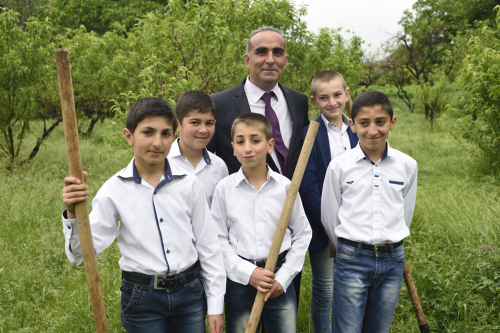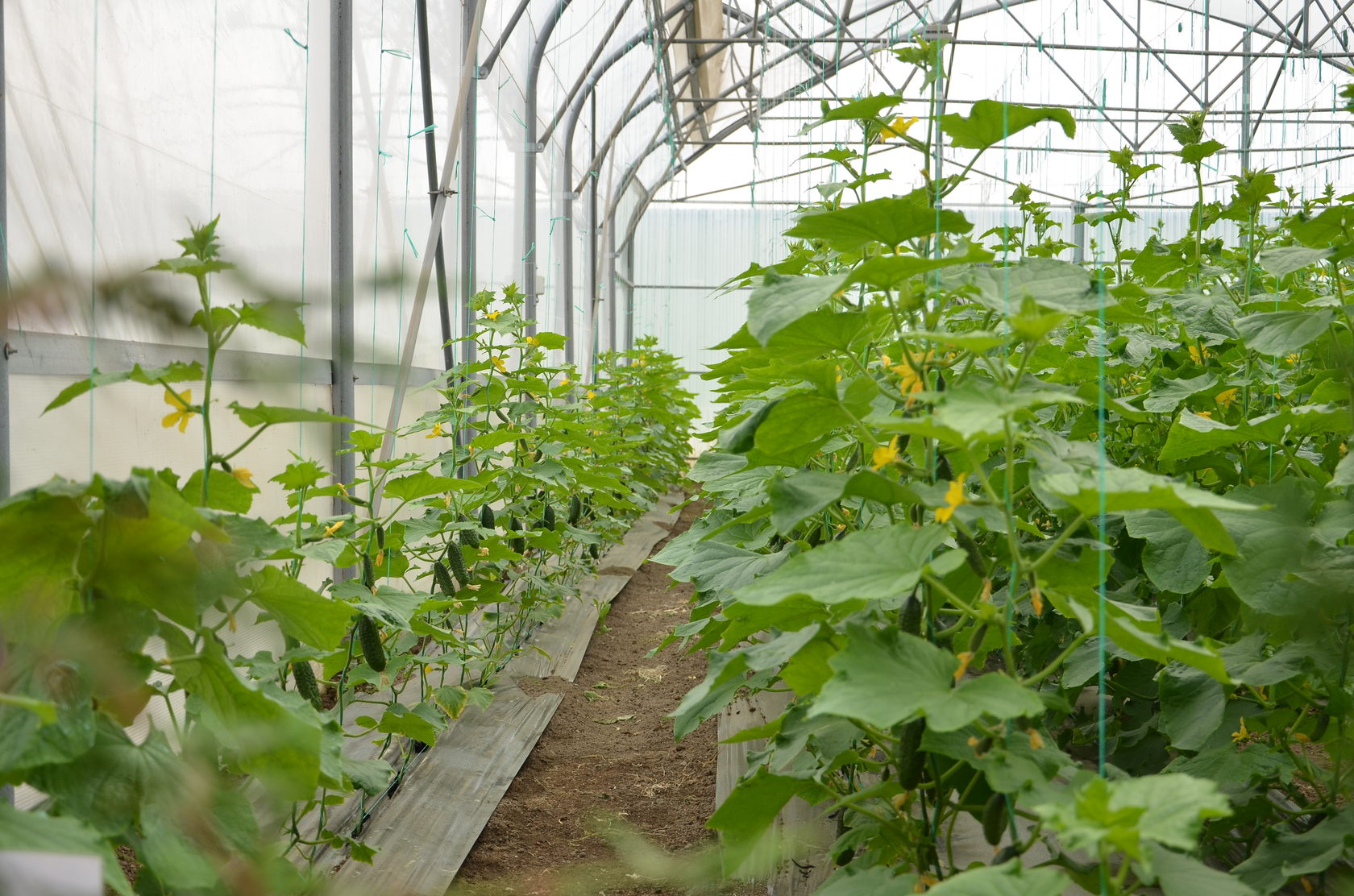Сonstruction of greenhouses with modern heating, ventilation and drip irrigation systems in three Armenian schools
Armenia
Greenhouses
Three greenhouses in three schools of Ararat region
- Vedi basic
school №1A small greenhouse that covers only the school needs for additional supply in greens and vegetables - Verin Artashat
secondary schoolA bigger greenhouse that covers the school needs and allows to sell the surpluses (earnings will be used for the school infrastructure development) - Surenavan
secondary schoolThe biggest greenhouse that produces food for the school itself, neighboring schools and for selling surpluses at the local market
Why a greenhouse?
First time after the collapse of the Soviet Union and independence Armenia thought about the restoration of the school feeding system in 2010, when the UN WFP project "Development of Sustainable School Feeding" started.
By the time of the beginning of the development of specific proposals for the FAO project, Armenia had already made a transition to a qualitatively new intermediate level of school feeding development in the country — in addition to the WFP programme, the National School Feeding Programme started in 2014.
Since 2010, the Social and Industrial Foodservice Institute has been actively involved in the school feeding development process both at the level of development of policy and strategic documents, and at a more practical "field" level. We have been working on the restoration of the school canteens' infrastructure and their re-equipment with new technological equipment. We have also been training cooks and school principals to provide schoolchildren with safe, tasty and nutritious school meals.
During the work, we closely communicate with school principals. This helps us to gain first-hand up-to-date information on what specific assistance schools need to improve the sustainability of the School Feeding Programme.
Since 2010, the Social and Industrial Foodservice Institute has been actively involved in the school feeding development process both at the level of development of policy and strategic documents, and at a more practical "field" level. We have been working on the restoration of the school canteens' infrastructure and their re-equipment with new technological equipment. We have also been training cooks and school principals to provide schoolchildren with safe, tasty and nutritious school meals.
During the work, we closely communicate with school principals. This helps us to gain first-hand up-to-date information on what specific assistance schools need to improve the sustainability of the School Feeding Programme.
School principals shared the various challenges they faced in implementing the School Feeding Programme: from fear to work with new equipment to lack of money for repair of school canteens and especially for diversification of school menu with fresh vegetables and greens. They were united by one thing - a great desire not just to feed children, but to provide them with tasty and healthy meals for their full development.
To increase the nutritional value of rations, the principals were ready to start growing vegetables and greens in the school territory and prepare fresh salads for children.
All they asked for was to help achieve that goal and build greenhouses for the schools. The climate in Armenia is quite changeable: autumn and winter can be very cold. It is in these seasons that children need additional sources of vitamins to fight colds and other viral diseases.
Thus was born the idea of a pilot project — the construction of greenhouses with modern heating, ventilation and drip irrigation systems in three Armenian schools.
However, we decided not to limit ourselves to standard greenhouses in all three schools, and took it a step further.
To increase the nutritional value of rations, the principals were ready to start growing vegetables and greens in the school territory and prepare fresh salads for children.
All they asked for was to help achieve that goal and build greenhouses for the schools. The climate in Armenia is quite changeable: autumn and winter can be very cold. It is in these seasons that children need additional sources of vitamins to fight colds and other viral diseases.
Thus was born the idea of a pilot project — the construction of greenhouses with modern heating, ventilation and drip irrigation systems in three Armenian schools.
However, we decided not to limit ourselves to standard greenhouses in all three schools, and took it a step further.
Testing new approaches
In school No. 1 of Vedi we established a small greenhouse with an area of about 198 sq. m. Vegetables and greens will be grown there to provide the students of the school with fresh salads.
Before establishing the second greenhouse we thought: "The school can sell surplus products to its employees or at the local market, and spend the money earned on the further development of school feeding. Why not?". So we decided to build a bigger greenhouse.
Before establishing the second greenhouse we thought: "The school can sell surplus products to its employees or at the local market, and spend the money earned on the further development of school feeding. Why not?". So we decided to build a bigger greenhouse.
The choice fell on the school of Verin Artashat village. The greenhouse of 384 sq. m will allow the school to provide itself with fresh vegetables at prices significantly below the market, and to sell the surplus at the local market and use the proceeds as an additional source of funding for school feeding at the school.
But what about the schools where there is no place to build a greenhouse? Leave children without healthy salads made of fresh vegetables? Of course not! Assistance to such schools can be provided by the neighbouring schools — with a larger area.
We have established the largest greenhouse of 528 sq. m in the school of Surenavan village. It can provide fresh vegetables and greens not only to its students but also to the children of neighboring schools.
But what about the schools where there is no place to build a greenhouse? Leave children without healthy salads made of fresh vegetables? Of course not! Assistance to such schools can be provided by the neighbouring schools — with a larger area.
We have established the largest greenhouse of 528 sq. m in the school of Surenavan village. It can provide fresh vegetables and greens not only to its students but also to the children of neighboring schools.
| Project Scope If money funds are available, building a greenhouse is very simple. But what's next? Does the school have a legal right to conduct commercial activities and to sell its products? How can we help the school obtain additional sources of funding for school feeding development? What is the proper way to care for seedlings? And, finally, what can be cooked from vegetables, except salads? We studied all these issues in detail, as well as the regulatory and legal framework existing in Armenia. Based on the studied materials, we have prepared the following guidelines and documents:
The trainings were conducted by agronomists specializing in vegetable production under cover. During the trainings, school principals and greenhouse workers learned how to prepare the soil and plants for planting, how to apply fertilizers and create all necessary conditions for the production of vegetables, how to water the plants properly and how to create a favorable climate in the greenhouse to get a good harvest. In the future, the modern technologies used in growing vegetables in greenhouses will be distributed among local farmers and rural residents and will help to qualitatively increase yields due to the transition to innovative practices. |

Upbringing the future agronomists
We could not help but use the greenhouse for educational purposes. It is at an early school age that the child begins to form an understanding of what he/she will do in the future, what is interesting for him/her. Therefore, our other goal was to interest children in agricultural activities and teach them to work in greenhouses.
We have developed a whole program, which was formalized in a manual for primary school teachers and a workbook for students. These materials will tell children how vegetables grow, what they need to grow, how to care for them. Interactive tasks, experiments and practical exercises of the course will teach children proper eating habits, hygiene and healthy lifestyle.
We could not help but use the greenhouse for educational purposes. It is at an early school age that the child begins to form an understanding of what he/she will do in the future, what is interesting for him/her. Therefore, our other goal was to interest children in agricultural activities and teach them to work in greenhouses.
We have developed a whole program, which was formalized in a manual for primary school teachers and a workbook for students. These materials will tell children how vegetables grow, what they need to grow, how to care for them. Interactive tasks, experiments and practical exercises of the course will teach children proper eating habits, hygiene and healthy lifestyle.
More projects to elliminate hunger


